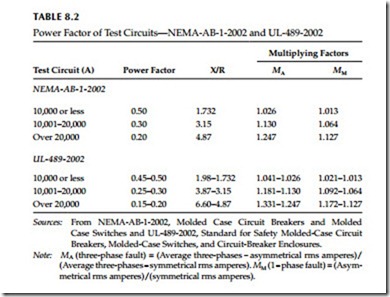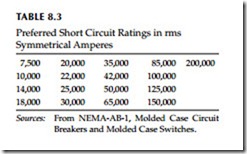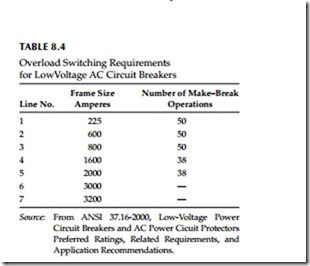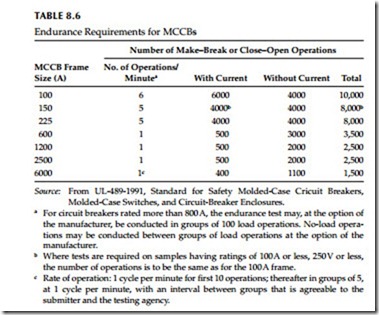Assessing Service Life of Low-Voltage Breakers
The National Electrical Manufacturers Association (NEMA), American Standards National Institute (ANSI), and Institute of Electrical and Electronic Engineers (IEEE) standards for low-voltage power circuit breakers and MCCBs contain performance criteria for assessing the service life of manufactured products. The pertinent industry standards for low-voltage breakers are ANSI/ IEEE C37.16-2000, C37.26-2003, C37.50-2000, C37.51-2003, NEMA AB-1-2002, and AB-4-2003. In addition, the MCCBs are tested at the manufacturer’s production facility and/or at UL facilities in accordance with standards promulgated by the industry and UL-489-2002. The performance criteria contained in these standards can also help users anticipate the need for maintenance testing, inspections, refurbishment, and/or replacement of the manufactured prod- ucts. This section provides an overview of the requirements covered in the referenced industry standards and the methods typically used by manufac- turers in making the products. It is expected that an understanding of the endurance requirements covered in the standards should provide insights that can be used to inspect and evaluate the health for continued reliable operation (i.e., the service life) of low-voltage power circuit breakers and MCCBs. There are four basic electrical ratings and endurance requirements for switchgear components and assemblies such as circuit breakers.
Maximum Voltage Rating or Nominal Voltage Class
Low-voltage power circuit breakers are marked with the maximum system voltage at which they can be applied. Standard maximum voltage ratings are 635, 508, and 254 V for application of the breakers in 575, 480, and 208 V electrical power systems, respectively. A low-voltage breaker can be used in a circuit that has a nominal voltage rating less than the breaker’s maximum voltage rating. For example, a 635 V rated circuit breaker can be applied in a 208, 240, 480, or 600 V rated circuit. For fused breakers, the 635 V maximum voltage rating becomes 600 V to match the voltage rating of the fuses.
Continuous Current Rating
The continuous current rating of a circuit breaker, isolator switch, load-break switch, switchgear assembly, or motor control center is the number of amperes; that the device can carry continuously without the temperature of any insulation component becoming greater than its rated temperature. For low-voltage power circuit breakers and MCCBs, the continuous current rating of the breaker’s frame is called the frame size. For any low-voltage power circuit breaker that can accept a replaceable trip device, installation of a trip device that has a continuous current rating that is less than the frame size reduces the continuous rating of the circuit breaker. It is not permissible to install a trip device that has a continuous current rating that is greater than the breaker’s frame size.
Rated Short-Circuit Current (Circuit Breakers)
Low-voltage circuit breakers are designed and manufactured with one or more interrupting ratings (rated short-circuit current), often called interrupting ampere capability (AIC). These interrupting ratings are the maximum values of available (prospective) short-circuit current (fault) that the breaker is able to interrupt (short-circuit duty cycle) at different maxi- mum voltage values. Available current is defined in the industry standards as the expected rms symmetrical value of current at a time one half-cycle after short-circuit initiation. The maximum fault in a power system occurs at one half-cycle time. The low-voltage breakers are fast acting and begin to part contacts at about one half-cycle time which is point of maximum short- circuit current. Therefore, as the breaker contacts begin to part, i.e., as the breaker begins to interrupt the short-circuit current it is subjected to the maximum asymmetrical current. The asymmetry of the short-circuit current is a function of the X/R ratio, or the power factor of the short-circuit current. The ANSI/UL standard 489, “Standard for molded case circuit breakers and circuit breaker enclosures” along with AB-1 contain the criteria for perform- ing interrupting ability tests for molded-case breakers. These standards specify the power factor of the test circuit with the required current flowing that is to be used for establishing the asymmetry of the short-circuit current. The NEMA AB-1-2002 and UL 489-2002 standards have established three asymmetry categories (i.e., power factor) of short-circuit current interrupting capabilities. The three asymmetry categories (short-circuit current and power factor) given in NEMA AB-1 and UL 489 are shown in first two columns of Table 8.2. The associated X/R ratio and the accompanying multiplying fac- tors are shown in columns 3 and 4 of Table 8.2. What the UL 489 and relevant industry standards are saying is that the asymmetry is greater for fault cur- rents at the locations where the short-circuit current is high, and it is smaller at locations where the short-circuit current is less. Another way of stating this criterion is to say that the breakers applied closer to the substations will experience higher short-circuit currents with higher asymmetry in the fault current, thereby subjecting a breaker to undergo a higher short-circuit duty while interrupting the fault. The opposite is true for breakers applied further away (downstream) from the substation because such breakers will see lower short-circuit currents and lower asymmetry in the short-circuit current.
What this all means is that power factor is lower (or X/R ratio is higher) near the substations and power factor is higher (or X/R ratio is lower) further away from the substation. It should be noted that the maximum asymmetry for the low-voltage circuit breakers is capped at power factor of 0.15, X/R ratio of 6.6. However, examination of the manufacturer and UL data shows that most breakers are tested at a maximum power factor of 0.20 or X/R ratio of 4.87. The low-voltage breaker’s short-circuit interrupting capability is indicated in sym- metrical amperes since the asymmetry is already included in the test circuit current when the breakers are tested for interrupting capability. Also, note that the short circuit duty cycle is a specific test that is performed on a prototype model of a circuit breaker. A detailed explanation of this test can be found in ANSI/IEEE standards C37.16, C37.50, UL 489, and NEMA AB-1. Table 8.3 shows
the interrupting symmetrical ampere capabilities published in NEMA AB-1 for the breakers manufactured by NEMA member companies.
Each model of circuit breaker can have a different set of interrupting current capabilities listed in Table 8.3. The interrupting capability of a low- voltage breaker varies with the applied voltage. For example, a 1600 A-rated breaker applied at 240 V might have an interrupting capability of 65 kA at 240 V, whereas the same breaker applied at 480 V would have an interrupt- ing capability of 50 kA. The interrupting capability also changes if the break- er’s automatic trip device has a short-time trip function rather than an INST trip function. For example, a 4000A-rated circuit breaker that has an INST trip might have an interrupting capability of 150 kA at 240 V, whereas the same breaker equipped with a short-time trip has an interrupting capability of 85 kA at 240 V. Any low-voltage power circuit breaker that is equipped with current- limiting fuses (current limiters) has short-circuit current rating equal to 200 kA. Rated short-circuit current is also influenced by the ability of a circuit breaker to close and latch against, carry, and subsequently interrupt, a fault current. Breakers have closing and latching capabilities, sometimes called momentary rating, relate to the breaker’s ability to withstand the mechanical and thermal stress of the first half-cycle of a fault current, i.e., asymmetrical short-circuit current. Low-voltage power circuit breakers and MCCBs display no nameplate information concerning momentary rating. These types of breakers are tradi- tionally tested and applied according to their interrupting current capability in RMS amperes. The reason that momentary ratings do not appear on their nameplates is that these breakers are tested with the asymmetry already included in the symmetrical amperes of the test circuit that was discussed earlier. For those few system applications that have a greater asymmetrical value than the asymmetry of test circuit current (i.e., X/R = 6.6), a circuit breaker of higher interrupting current rating should be applied.
Short-Circuit Current Ratings—Panelboards, MCCs, and Switchgear Assemblies A panelboard has a short-circuit current rating shown on its nameplate. A pan- elboard is not allowed to be applied in any circuit whose available fault cur- rent is greater than its short-circuit current rating. The short-circuit current rating of a panelboard is limited to the lowest value of rated short-circuit current for any circuit breaker that is installed within the panelboard. The short circuit withstand rating of a motor control center is the average rms current that its busses can carry for 2 s. A motor control center is not allo- wed to be applied in any circuit whose available fault current is greater than its short-circuit withstand rating. The rated momentary current of metal-enclosed or metal-clad switchgear represents the maximum rms current that it is required to withstand during a test of 10 cycles duration. This test is conducted on a prototype model. The rated short-time current of metal-enclosed or metal-clad switchgear is the average rms current that it can carry for a period of 2 s.
Endurance Requirements for Low-Voltage Breakers
The ANSI/IEEE standard for switchgear C37.16-2000 provides endurance requirements of low-voltage power circuit breakers and AC power circuit protectors. Although primarily used by manufacturers who have an interest in assuring a durable product, these endurance requirements can also help equipment users to anticipate the need for maintenance or replacement. In order to verify that a particular design of circuit breaker meets the endur- ance requirements, a manufacturer performs all endurance tests on a single circuit breaker. Table 8.4 appears in the standard and represents the number of times that the circuit breaker is required to make and subsequently break line currents that are 600% of the breaker’s rated continuous current. The test method includes specifications for how much time can elapse between switching operations. The breaker components that are most likely to become worn during this endurance test are arcing tip and arc chutes.
Table 8.5 also appears in the ANSI 37.16-2000 and represents the number of open–close or close–open operations that the breaker’s operating mechanism is required to endure when making and breaking 100% of its rated current (electrical endurance) and no current (mechanical endurance). The components that are most likely to become worn during this endurance test are latches, cam, rollers, bearings, pins, clamps, and threaded hardware. In order to pass this test, adjusting, cleaning, lubricating, and tightening are allowed at the intervals shown in column 2 of Table 8.5. The numbers in this column contain a clear implication that maintenance is required in order to allow a circuit breaker’s operating mechanism to realize its full lifetime. An examination of the Annex A ANSIC37.16-2000 reveals several comments that relate strongly to breaker maintenance. These comments are (1) The circuit breaker should be in a condition to carry its rated continuous current
at maximum rated voltage and perform at least one opening operation at rated short-circuit current. After completion of this series of operations, functional part replacement and general servicing may be necessary, (2) If a fault operation occurs before the completion of the listed operations, servic- ing may be necessary, depending on previous accumulated duty, fault mag- nitude, and expected future operation, (3) Servicing consists of adjusting, cleaning, lubricating, tightening, and the like, as recommended by the man- ufacturer. When current is interrupted, dressing of contacts may be required as well. As indicated in the standards, the breaker operations listed for endurance are based on servicing at intervals of 6 months or less.
The implication for maintenance is that a power circuit breaker might not be suitable for continued service after it has interrupted a fault current at or near its short-circuit current rating. Unless the magnitude of a fault current is known to have been significantly less than rated short circuit value, it is good practice to perform a physical inspection on a breaker before it is used to reenergize a power circuit. Physical inspections at periodic maintenance intervals will reveal wear of components and parts before a circuit breaker looses its ability to interrupt an overload current or a fault. For circuit breakers that are equipped with a monitoring system, the number of overload operations can be automatically recorded in a data log that can subsequently be analyzed to determine whether a circuit breaker is in need of an inspection.
The requirements for conducting endurance tests for MCCBs are given in NEMA AB-1 and UL-489 and the criteria differ somewhat from the ANSI C37.16 requirements. The categories of electrical operations are referred to as operation with current and the mechanical tests are referred to as operation without current. The requirements for the endurance tests for MCCB are shown in Table 8.6.




